What in the world would you think having four or more holes just astern of your kayak!?
What in the world would you think having four or more holes just astern of your kayak!?
However, the factors have their reasons for that. First-timers to kayaking consider ‘Why do I need these holes in my kayak? Or Why do kayaks have holes?
The scuppers in your kayak are actual holes. The scupper is shaped into the kayak form that lets water that has speckled inside it come back out. The number of scuppers is four, but there can be up to ten scuppers on kayak. The scuppers, usually, come near the seat and the storage boxes.
You are bound to have questions and there is a lot that you will become acquainted with the first time you kayak fish. Yes, and that seems to be the hole that excites some people yet.
So let’s begin with the past of the scupper!
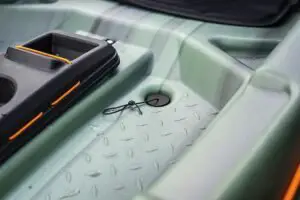
What Are Scupper Holes?
Every kayak manufacturer of sit-on-top style designs their products with scupper holes. They are available in the range from the most expensive fishing kayaks down to the least expensive model. That’s right folks, scuppers are just that important!
Type-iii kayaks of the present age have scupper holes too, but scupper isn’t the creation of the present generation! These date back to the beginning of history to the times when most sea-going adventurers were Inuits.
The Inuits utilized kayaks and hunted fish near the coastal areas and inland waterways many centuries ago, close to the ice flows! Therefore even today, we are partly bearing in their knowledge!
Therefore such kayaks sat lower in the water hence their kayaks got more buried by the breaking waves while unused over the ocean. This was not a positive thing.
Finally, the Inuits of the Arctic regions conceived the spray skirts which were made of sealskin layers to keep the kayaks water-resistant, and they were able to hunt and fish from their kayaks far safer than before!
Most sit-on-top kayaks have a scupper hole at the back of the kayak to allow the water to be drained from the kayak once it’s pulled out of the water onto land.
Sit-on-top kayaks were developed and made available to the public with kayaking and fishing while sitting on the kayak gaining more popularity. The platform is a buoyant system with a seat on it.
We have all these small golf ball-sized holes in the ground decking of our kayak that act as scupper holes. Through them, we allow any water that might find its way onto the kayak to drain back into the water.
For nearly all fishing kayaks on the water right now, the normal-sized scupper is 1.25″ or 3.175 cm for you if you´re using metric units.
Scupper holes are the deliberate holes at the bottom of sit-on-top kayaks, e.g. fishing kayaks. It seems counter-intuitive to have holes in a boat, but they serve a couple of important design purposes: It seems counter-intuitive to have holes in a boat, but they serve a couple of important design purposes:
- They make the kayak structurally robust…
- They work as a storm drain when you have water in your boat. For example, this is critical in rapids and waves when there is continuous water splashing over the top.
Do I Need to Plug the Holes in My Kayak?
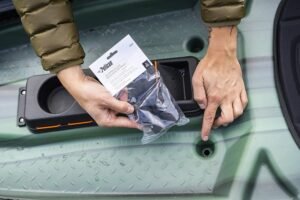
What is left to do now is to plug those holes in your kayak. Then, when they come in, what happens?
If you are routing in areas with rough waters and water splashing on your kayak, you need to let water in through the scuppers so that it can drain. Otherwise, the kayak may fill with water and become difficult to maneuver, and it may even capsize. Calm waters allow you to plug your scuppers, therefore, you will not be wet if you fall overboard. The correct scupper plugs are user-friendly and are easy to put in, as well as takeoff.
Some people even now choose to plug the holes in their scuppers, and others keep them open all the time. In my opinion, it’s a good idea for you to be able to paddle with them open or closed at any time when the weather conditions require them to be.
Somewhere the water line is located on your kayak, the water level will be the same inside the scupper hole.
If you’re a heavier person, or carrying more gear than normal, the water line can rise within the scupper, or even enter the bottom of your kayak!
If this is the case, you would want to plug your scuppers to keep water from entering through the bottom or kayak with a craft rated for your weight and load capacity.
Sit-on-top kayaks generally have well-raised seats with scupper holes beneath them. If you have a kayak rated for your weight and load capacity, any water coming in should drain out.
This will keep you sitting in a puddle while fishing!
How Many Scupper Holes to Plug or UnPlug?
The scupper hole has consistent water depth regardless of where the waterline is on the kayak.
If you are heavier than normal, or carrying more equipment than usual, the water will rise to that level or even enter the bottom of your kayak!
Under this condition, you should stop your water from coming in through the bottom of the ship, or choose a kayak that has been crafted as per your weight and load capacity guidelines.
Sit-on-top kayaks typically have padded high-back seats with scupper holes at the very bottom of the seats. The problem with the kayak is that the water that gets into it may not necessarily drain out if the kayak is not properly made for your weight and load size.
Fishing will be perfect coz you will be in the water and with it.
If at all, it comes to you with very quiet situations where water doesn’t flow into the kayak, you then choose to unclog all the scupper holes. The appropriate placement will provide a chance for free draining and ventilation with nothing to worry about your kayak getting wet.
Nevertheless, for the softer waters that may only be associated to splashes, you might want to leave the scupper holes unplugged. On the other hand, if you are sitting in some rough waters or encountering waves that lead to a significant amount of water intake by the kayak, you may consider covering some, or all, of the scupper holes.
The selection of scupper plugs can be quite straightforward and diverse; on one hand, we have simple sponge inserts while on the other extreme, some highly advanced designs have been developed which feature an adjustable valve. Identifying with different kinds of fittings might help you to succeed in preventing the water from reaching the inside of the house, but not yet having proper draining.
Therefore, it should be worthwhile for every kayaker to reflect on his/her exclusive needs and the current set of environmental conditions he/she is paddling in when pondering on how many scupper holes to unplug or plug. It would apply if you work with various installations and evaluate what is better for your kayak and you. Well, as long as you don’t forget to be on the safe side, that is, keeping the holes wide open for drainage or tightly sealed to stop the water from reaching you, everything can be alright.
Scupper Holes in Rough Waters
The typical kayak includes 6-8 scupper holes (most of them being positioned at different points in the boat). Gene has a preference for the rear holes being ‘plugged’ as it’s where most weight is loaded. Tying them off pulls up the boat a slight bit which allows less water entry. It also keeps that area drier.
Whether you are smaller and a little bit lighter or bigger and heavier, you will have to make up your attention about which of the choices you choose. If you need some more kick on longer rides, then turn them on. If you’re a light-weight and need warmer waters you will enjoy them unplugged.
If Gene occupies the boat during the ups and downs of the waves or he gets the water from the rain, he’ll get the holes blocked to empty the water.
While focused on direction-finding, Gene uses forward scupper holes as main drains and leaves them most of the time…except during cold weather. When the old timer is out fishing in the cold he always keeps his holes plugged so that the cold water does not go inside his boat. Equally important would be to have a drier boat in the given circumstance.
Scupper Holes in Calm Waters
On the other hand, when the water is calm, and it is my preference, I would rather plug the scuppers Rod!
The truth about Sit-on-top kayaks is that they can take water in from above and below! With me on board, my weight and gear would result in hull immersion more than yours, adding water over scuppers.
I’m happy to have my scupper holes plugged in because the water from underneath is now minimal the water is pretty calm, and the water splashing over the side is no more. Nothing more than what my paddle may drip from and of which while paddling from time to time.
Do I Leave the Plugs In All the Time?
The majority of kayakers will have the scuppers plugged in at all times. They simultaneously create a space organizer in the cockpit and a cover for the scupper holes when necessary.
If you would want the plugs place in so that water from waves can’t come up through the holes at all because you are in a lake, do so.
It’s an absolute must that you take them out if you’re not in the smoother parts of the water and are tramping through the whitecaps, frankly. Simply having the scupper holes open lets the water, which is breaking over your kayak, go out through them!
Why do kayaks have holes: CONCLUSION
At last, the bow holes or openings in kayaks perform a few essential functions, which together form the usability and the safety of the watercraft.
The scupper holes, one of the main reasons for having them, are to help the water flowing off the kayak, ensuring that the cockpit is not flooded. Regardless of whether they are tackling waves, or just splashing water as they go, it is practically going to result in the kayak getting some water inside it. This water, when there is no drainage system, can creep up the hull, which could lead to instability, excessive weight gain, and increase the chances of damage. Scupper holes contribute to a humble and applied solution just by using the holes that let the water run out of the kayak, keeping it dry and floatable.
The scupper holes have other benefits besides that they help with self-draining and sit-on-top designs in particular. These types of kayaks are designed with glade decks, therefore they have all the possibility of getting water intake. But, with a smart placement of the scupper hole right in the cockpit area, water that deliberately enters the kayak can discharge really fast, hence, giving you a more comfort and less water among you.
While kayaks give you a chance to enjoy the serenity of nature, moisture also tends to build up inside. To prevent such, kayaks are designed with holes that allow in air ventilation. Very often, airing holes or vents in the sealed cockpit of a kayak are there to control air flow both in the cockpit and the hull. This will prevent excessive water from collecting within the cabin, hence endorsing a comfortable, mold, mildew, and odor-free ride. Through the exchange of air the holes of ventilation contribute to keep the kayak healthier and better as a place to stay in than inside where there is no air refreshing.
Similar to this, there are some kayak designs with a number of holes or mounts in them where fishermen can assign their fishing rod holders or camera mounts, and storage compartment for their gear. Through these many openings, paddlers are given the freedom to set up their kayak in their own way in addition to adapt their boat to exactly what they need or want to fulfill their specific water needs.

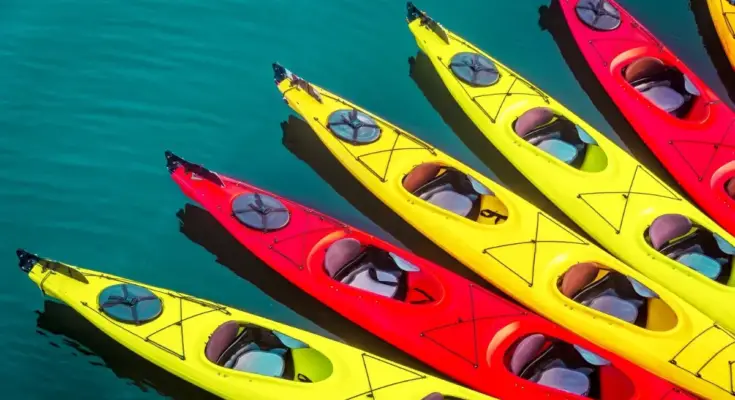
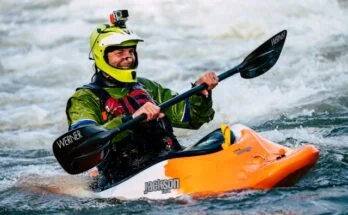
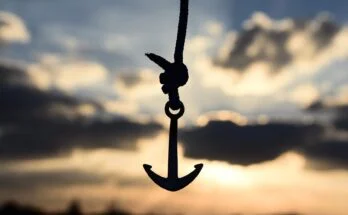
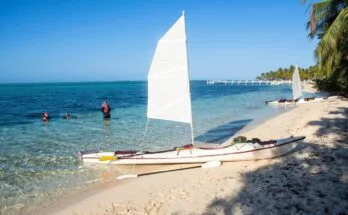
Thanks a ton for your post. I would like to write my opinion that the cost of car insurance differs from one policy to another, since there are so many different issues which bring about the overall cost. One example is, the make and model of the motor vehicle will have a tremendous bearing on the fee. A reliable ancient family car or truck will have a more economical premium than just a flashy fancy car.
Hi there just wanted to give you a brief heads up and let you know a few of the pictures aren’t loading properly. I’m not sure why but I think its a linking issue. I’ve tried it in two different internet browsers and both show the same outcome.
Thank you for cooperation We will check it and solve your query thank you
I’ve been browsing online more than three hours today, yet I never found any interesting article like yours. It is pretty worth enough for me. In my opinion, if all webmasters and bloggers made good content as you did, the internet will be much more useful than ever before.
Thank you for being a shining light, a pillar of support, and a source of inspiration. Your kindness has not gone unnoticed, and I want you to know how much it means to me.
I’ve learned newer and more effective things by means of your blog. One other thing I’d prefer to say is the fact that newer laptop operating systems have a tendency to allow more memory to use, but they additionally demand more ram simply to operate. If a person’s computer can’t handle extra memory as well as newest computer software requires that memory space increase, it can be the time to shop for a new Laptop or computer. Thanks
Thank you for being a shining light, a pillar of support, and a source of inspiration. Your kindness has not gone unnoticed, and I want you to know how much it means to me.
You could certainly see your enthusiasm in the paintings you write. The arena hopes for more passionate writers like you who are not afraid to mention how they believe. All the time follow your heart.